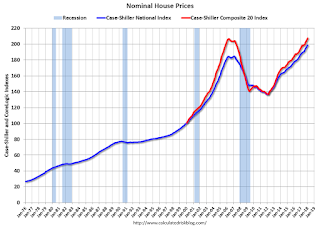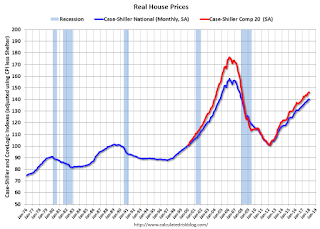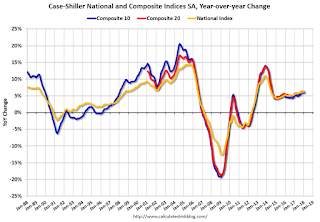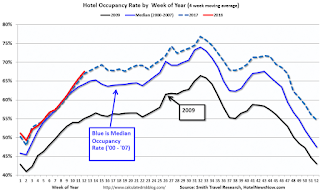by Calculated Risk on 3/27/2018 01:01:00 PM
Tuesday, March 27, 2018
Real House Prices and Price-to-Rent Ratio in January
Here is the earlier post on Case-Shiller: Case-Shiller: National House Price Index increased 6.2% year-over-year in January
It has been more than ten years since the bubble peak. In the Case-Shiller release this morning, the seasonally adjusted National Index (SA), was reported as being 7.6% above the previous bubble peak. However, in real terms, the National index (SA) is still about 11.1% below the bubble peak (and historically there has been an upward slope to real house prices).
The year-over-year increase in prices is mostly moving sideways now around 6%. In January, the index was up 6.2% YoY.
Usually people graph nominal house prices, but it is also important to look at prices in real terms (inflation adjusted). Case-Shiller and others report nominal house prices. As an example, if a house price was $200,000 in January 2000, the price would be close to $284,000 today adjusted for inflation (42%). That is why the second graph below is important - this shows "real" prices (adjusted for inflation).
Nominal House Prices

In nominal terms, the Case-Shiller National index (SA)and the Case-Shiller Composite 20 Index (SA) are both at new all times highs (above the bubble peak).
Real House Prices

In real terms, the National index is back to November 2004 levels, and the Composite 20 index is back to April 2004.
In real terms, house prices are back to 2004 levels.
Price-to-Rent
In October 2004, Fed economist John Krainer and researcher Chishen Wei wrote a Fed letter on price to rent ratios: House Prices and Fundamental Value. Kainer and Wei presented a price-to-rent ratio using the OFHEO house price index and the Owners' Equivalent Rent (OER) from the BLS.

This graph shows the price to rent ratio (January 2000 = 1.0).
On a price-to-rent basis, the Case-Shiller National index is back to January 2004 levels, and the Composite 20 index is back to October 2003 levels.
In real terms, prices are back to mid 2004 levels, and the price-to-rent ratio is back to late 2003, early 2004 - and the price-to-rent ratio has been increasing slowly.
Richmond Fed: "Fifth District Manufacturing Firms Reported Sluggish Growth in March"
by Calculated Risk on 3/27/2018 10:13:00 AM
From the Richmond Fed: Fifth District Manufacturing Firms Reported Sluggish Growth in March
Fifth District manufacturing expanded at a slower pace in March, according to the most recent survey results from the Federal Reserve Bank of Richmond. The composite index dropped from a particularly strong reading of 28 in February to 15 in March as each of the three components (shipments, new orders, and employment) fell. However, for each of these variables, a larger share of firms predicted growth in six months than had in February. Firms reported weaker growth in capital expenditures in March but saw an uptick in growth of business services expenditures.This was the last of the regional Fed surveys for March.
The survey's employment measures suggested slower growth in March. While the availability of skills index increased in March, it remained in negative territory indicating that skills shortages persisted. Firms anticipate stronger growth in all employment measures in the coming months.
District manufacturers saw higher growth in prices paid in March, but growth in prices received slowed slightly. However, firms expected to see accelerating price increases for both prices paid and received in the next six months.
emphasis added
Here is a graph comparing the regional Fed surveys and the ISM manufacturing index:
 Click on graph for larger image.
Click on graph for larger image.The New York and Philly Fed surveys are averaged together (yellow, through March), and five Fed surveys are averaged (blue, through March) including New York, Philly, Richmond, Dallas and Kansas City. The Institute for Supply Management (ISM) PMI (red) is through February (right axis).
Based on these regional surveys, it seems likely the ISM manufacturing index will be solid again in March, but probably lower than in February (to be released Monday, April 2nd).
Case-Shiller: National House Price Index increased 6.2% year-over-year in January
by Calculated Risk on 3/27/2018 09:12:00 AM
S&P/Case-Shiller released the monthly Home Price Indices for January ("January" is a 3 month average of November, December and January prices).
This release includes prices for 20 individual cities, two composite indices (for 10 cities and 20 cities) and the monthly National index.
Note: Case-Shiller reports Not Seasonally Adjusted (NSA), I use the SA data for the graphs.
From S&P: S&P CoreLogic Case-Shiller National Home Prices: All 20 Cities Up Year-over-year
The S&P CoreLogic Case-Shiller U.S. National Home Price NSA Index, covering all nine U.S. census divisions, reported a 6.2% annual gain in January, down from 6.3% in the previous month. The 10-City Composite annual increase came in at 6.0%, no change from the previous month. The 20-City Composite posted a 6.4% year-over-year gain, up from 6.3% in the previous month.
Seattle, Las Vegas, and San Francisco reported the highest year-over-year gains among the 20 cities. In January, Seattle led the way with a 12.9% year-over-year price increase, followed by Las Vegas with an 11.1% increase and San Francisco with a 10.2% increase. Twelve of the 20 cities reported greater price increases in the year ending January 2018 versus the year ending December 2017.
...
Before seasonal adjustment, the National Index posted a month-over-month gain of 0.05% in January. The 10-City and 20-City Composites both reported increases of 0.3%. After seasonal adjustment, the National Index recorded a 0.5% month-over-month increase in January. The 10-City and 20-City Composites posted 0.7% and 0.8% month-over-month increases, respectively. Sixteen of the 20 cities reported increases in January before seasonal adjustment, while all 20 cities reported increases after seasonal adjustment.
“The home price surge continues,” says David M. Blitzer, Managing Director and Chairman of the Index Committee at S&P Dow Jones Indices. “Since the market bottom in December 2012, the S&P Corelogic Case-Shiller National Home Price index has climbed at a 4.7% real – inflation adjusted – annual rate. That is twice the rate of economic growth as measured by the GDP. While price gains vary from city to city, there are few, if any, really weak spots. Seattle, up 12.9% in the last year, continues to see the largest gains, followed by Las Vegas up 11.1% over the same period. Even Chicago and Washington, the cities with the smallest price gains, saw a 2.4% annual increase in home prices.
“Two factors supporting price increases are the low inventory of homes for sale and the low vacancy rate among owner-occupied housing. The current months-supply -- how many months at the current sales rate would be needed to absorb homes currently for sale -- is 3.4; the average since 2000 is 6.0 months, and the high in July 2010 was 11.9. Currently, the homeowner vacancy rate is 1.6% compared to an average of 2.1% since 2000; it peaked in 2010 at 2.7%. Despite limited supplies, rising prices, and higher mortgage rates, affordability is not a concern. Affordability measures published by the National Association of Realtors show that a family with a median income could comfortably afford a mortgage for a median priced home.”
emphasis added
 Click on graph for larger image.
Click on graph for larger image. The first graph shows the nominal seasonally adjusted Composite 10, Composite 20 and National indices (the Composite 20 was started in January 2000).
The Composite 10 index is off 2.4% from the peak, and up 0.7% in January (SA).
The Composite 20 index is up slightly from the bubble peak, and up 0.8% (SA) in January.
The National index is 7.6% above the bubble peak (SA), and up 0.5% (SA) in January. The National index is up 45.6% from the post-bubble low set in December 2011 (SA).
 The second graph shows the Year over year change in all three indices.
The second graph shows the Year over year change in all three indices.The Composite 10 SA is up 5.9% compared to January 2017. The Composite 20 SA is up 6.3% year-over-year.
The National index SA is up 6.1% year-over-year.
Note: According to the data, prices increased in all 20 of 20 cities month-over-month seasonally adjusted.
I'll have more later.
Monday, March 26, 2018
Tuesday: Case-Shiller House Prices
by Calculated Risk on 3/26/2018 05:57:00 PM
From Matthew Graham at Mortgage News Daily: Mortgage Rates Slightly Higher to Begin Shortened Week
Mortgage rates moved sideways to slightly higher today, keeping them in an exceptionally narrow range that's persisted for the entire month of March. As of last Thursday, rates looked like they might make an attempt to challenge the lower boundary of that range, but they quickly backed off (or backed "up" as the case may be). Friday and today have seen a fairly steady move back toward the middle of March's range.Tuesday:
Context is also important. While we can talk about "movement" in a literal sense in the past few days, for all practical purposes, the average mortgage seeker wouldn't be seeing much of a difference. [30YR FIXED - 4.5-4.625%]
emphasis added
• At 9:00 AM ET, S&P/Case-Shiller House Price Index for January. The consensus is for a 6.2% year-over-year increase in the Comp 20 index for January.
• At 10:00 AM, Richmond Fed Survey of Manufacturing Activity for March. This is the last of the regional surveys for March.
Vehicle Sales Forecast: Sales Under 17 Million SAAR in March
by Calculated Risk on 3/26/2018 02:56:00 PM
The automakers will report March vehicle sales on Tuesday, April 3rd.
Note: There were 28 selling days in March 2018, up from 27 in March 2017.
From WardsAuto: U.S. Light-Vehicle Forecast: Sales Down Slightly; Inventory Declines to Match Demand
A Wards Intelligence forecast calls for U.S. automakers to deliver 1.60 million light vehicles in March. ... The report puts the seasonally adjusted annual rate of sales for the month at 16.9 million units, higher than last year’s 16.7 million but slightly under last month’s 17.0 million.Sales in March will probably be at the slowest sales rate since last August. After August, sales were boosted by the hurricanes.
emphasis added
Black Knight: National Mortgage Delinquency Rate Decreased Slightly in February
by Calculated Risk on 3/26/2018 12:42:00 PM
From Black Knight: Black Knight’s First Look at February 2018 Mortgage Data
• The national delinquency rate edged slightly downward in February, with hurricane-related delinquencies declining by a modest 5.0 percent for the monthAccording to Black Knight's First Look report for February, the percent of loans delinquent decreased 0.2% in February compared to January, and increased 2.1% year-over-year.
• Serious delinquencies (90 or more days past due) attributed to Hurricanes Harvey and Irma fell just 3.0 percent
• 128,000 hurricane-driven seriously delinquent mortgages remain in Texas, Florida, and Georgia
• After hitting a 12-month high in January, foreclosure starts fell 25 percent month-over-month
• Active foreclosure inventory rebounded from January’s increase, reaching a new post-recession low
• Rising interest rates pushed prepayment activity to the lowest level since 2014
The percent of loans in the foreclosure process decreased 1.8% in February and were down 30% over the last year.
Black Knight reported the U.S. mortgage delinquency rate (loans 30 or more days past due, but not in foreclosure) was 4.30% in February, down from 4.31% in January.
The percent of loans in the foreclosure process decreased slightly in February to 0.65%.
The number of delinquent properties, but not in foreclosure, is up 63,000 properties year-over-year, and the number of properties in the foreclosure process is down 139,000 properties year-over-year.
| Black Knight: Percent Loans Delinquent and in Foreclosure Process | ||||
|---|---|---|---|---|
| Feb 2018 | Jan 2018 | Feb 2017 | Feb 2016 | |
| Delinquent | 4.30% | 4.31% | 4.21% | 4.45% |
| In Foreclosure | 0.65% | 0.66% | 0.93% | 1.30% |
| Number of properties: | ||||
| Number of properties that are delinquent, but not in foreclosure: | 2,198,000 | 2,202,000 | 2,135,000 | 2,252,000 |
| Number of properties in foreclosure pre-sale inventory: | 331,000 | 337,000 | 470,000 | 655,000 |
| Total Properties | 2,528,000 | 2,539,000 | 2,605,000 | 2,907,000 |
Dallas Fed: "Texas Manufacturing Expansion Continues but at a Slower Pace"
by Calculated Risk on 3/26/2018 10:36:00 AM
From the Dallas Fed: Texas Manufacturing Expansion Continues but at a Slower Pace
Texas factory activity continued to expand in March, albeit at a markedly slower pace than last month, according to business executives responding to the Texas Manufacturing Outlook Survey. The production index, a key measure of state manufacturing conditions, fell 15 points to 12.7, signaling a deceleration in output growth.This is still a solid report. So far all of the regional surveys have been solid in March.
Other indexes of manufacturing activity also remained positive but posted double-digit declines in March. The new orders and growth rate of orders indexes fell to 8.3 and 3.8, respectively. The capacity utilization index dropped to 9.6, and the shipments index plunged 23 points to 9.3. Although these indexes are down notably from their February readings, they remain well above their postrecession averages.
Perceptions of broader business conditions remained positive on net, but the share of firms reporting an improvement declined from last month. The general business activity index fell 16 points to 21.4, and the company outlook index declined 12 points to 19.6. While both of these March readings represent the lowest this year, they are on par with last year’s average indexes and far above their postrecession average levels.
Labor market measures suggested growth was weaker for employment and workweek length. The employment index came in at 10.8, down eight points from February. Twenty percent of firms noted net hiring, compared with 9 percent noting net layoffs. The hours worked index moved down to 9.4.
emphasis added
Chicago Fed "Index points to a pickup in economic growth in February"
by Calculated Risk on 3/26/2018 09:28:00 AM
From the Chicago Fed: Index points to a pickup in economic growth in February
Led by improvements in production-related indicators, the Chicago Fed National Activity Index (CFNAI) rose to +0.88 in February from +0.02 in January. All four broad categories of indicators that make up the index increased from January, and three of the four categories made positive contributions to the index in February. The index’s three-month moving average, CFNAI-MA3, increased to +0.37 in February from +0.16 in January.This graph shows the Chicago Fed National Activity Index (three month moving average) since 1967.
emphasis added
 Click on graph for larger image.
Click on graph for larger image.This suggests economic activity was above the historical trend in February (using the three-month average).
According to the Chicago Fed:
The index is a weighted average of 85 indicators of growth in national economic activity drawn from four broad categories of data: 1) production and income; 2) employment, unemployment, and hours; 3) personal consumption and housing; and 4) sales, orders, and inventories.
...
A zero value for the monthly index has been associated with the national economy expanding at its historical trend (average) rate of growth; negative values with below-average growth (in standard deviation units); and positive values with above-average growth.
Sunday, March 25, 2018
Sunday Night Futures
by Calculated Risk on 3/25/2018 07:20:00 PM
Weekend:
• Schedule for Week of Mar 25, 2018
Monday:
• At 8:30 AM ET Chicago Fed National Activity Index for February. This is a composite index of other data.
• At 10:30 AM, Dallas Fed Survey of Manufacturing Activity for March.
From CNBC: Pre-Market Data and Bloomberg futures: S&P 500 are up 7, and DOW futures are up 80 (fair value).
Oil prices were up over the last week with WTI futures at $65.86 per barrel and Brent at $70.50 per barrel. A year ago, WTI was at $48, and Brent was at $51 - so oil prices are up solidly year-over-year.
Here is a graph from Gasbuddy.com for nationwide gasoline prices. Nationally prices are at $2.61 per gallon. A year ago prices were at $2.29 per gallon - so gasoline prices are up 32 cents per gallon year-over-year.
Hotels: Occupancy Rate Up Year-over-Year
by Calculated Risk on 3/25/2018 08:41:00 AM
From HotelNewsNow.com: STR: US hotel results for week ending 17 March
The U.S. hotel industry reported positive year-over-year results in the three key performance metrics during the week of 11-17 March 2018, according to data from STR.The following graph shows the seasonal pattern for the hotel occupancy rate using the four week average.
In comparison with the week of 12-18 March 2017, the industry recorded the following:
• Occupancy: +1.0 at 70.7%
• Average daily rate (ADR): +2.8% to US$133.76
• Revenue per available room (RevPAR): +3.9% to US$94.55
emphasis added
 Click on graph for larger image.
Click on graph for larger image.The red line is for 2018, dash light blue is 2017 (record year due to hurricanes), blue is the median, and black is for 2009 (the worst year since the Great Depression for hotels).
Currently the occupancy rate, to date, is fifth overall - and slightly ahead of the record year in 2017 (2017 finished strong due to the impact of the hurricanes).
Data Source: STR, Courtesy of HotelNewsNow.com


